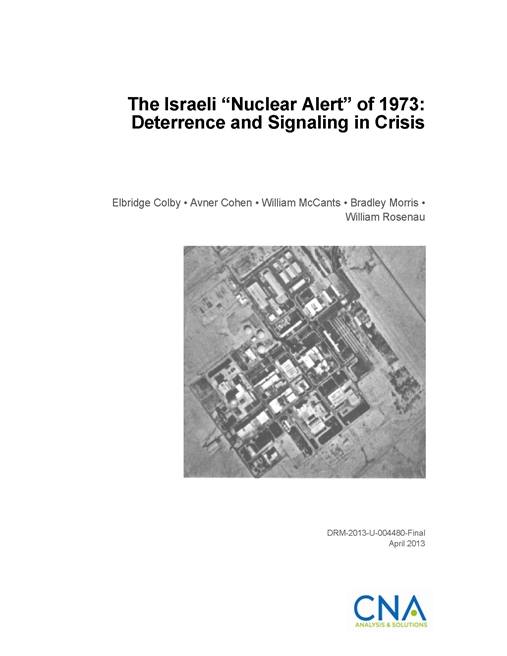On the afternoon of October 6, 1973, on Yom Kippur, the holiest day in the Jewish calendar, the armies of Egypt and Syria launched major assaults against Israeli positions along the Suez Canal and in the Golan Heights. Within a day, Arab armies had seized the east bank of the Canal and substantial territory in the Heights, and had repelled Israeli air and ground counterattacks. The mood in the Israeli high command was dark, and in some places almost apocalyptic. Moshe Dayan, defense minister and national hero, went so far as to suggest that the very existence of Israel – “the third Temple” – could be in jeopardy.
It has long been rumored that in this desperate context Israel alerted or somehow manipulated its nuclear forces – perhaps in order to “blackmail” the United States into providing greater support, as one American journalist alleges, or to deter further Arab assault. If true, this would constitute one of the very few serious nuclear “threats” of the nuclear era. This in and of itself makes it a topic of enduring interest. But in light of the continued and perhaps growing salience of nuclear weapons – and thus also their political “uses”– in the hands of U.S. adversaries as well as allies and partners, this study is of more than antiquarian interest because, in concert with other examples drawn from crises and conflicts, it helps elucidate how nuclear weapons can affect and influence the course of politics and war.
Yet there has never been a serious, in-depth study of this incident that has had access not only to key participants (both American and Israeli) and open sources, but also to the tremendous store of U.S. Government documents pertaining to the Yom Kippur War. This study is the first of this kind on this incident and represents the results of almost a year of extensive research in U.S. Government archives and in the open literature, numerous interviews with participants and experts, and the convocation of a workshop to discuss the issue.
After this exhaustive review, our conclusion is that Israel likely did take some steps associated with the readying of its nuclear weapons and/or nuclear weapons delivery forces in the very early stages of the Yom Kippur War, but that these steps were defensive or precautionary in nature and were not designed to send a signal to the United States, the Arabs, or anyone else. We assess that it is also very likely that the United States did observe this activity and that the report of the activity was disseminated to key decision-makers – but that the report did not have any significant impact on U.S. decision-making. Rather, U.S. (and likely all nations’) decision-makers were aware of the possibility of Israeli nuclear use as an implicit reality, but they judged that it was only plausible in extremis, and American leaders did not believe the situation, even in the dark hours of October 7, had reached those depths.
We also assess that there was pressure within the Israeli defense establishment to consider preparation for nuclear use, however, particularly by Defense Minister Moshe Dayan. We judge that it is likely that Dayan suggested that the Israeli supreme war cabinet (led by Prime Minister Golda Meir) consider the more substantial readying of Israel’s nuclear forces for a possible “demonstration” usage on or about October 7 – but that Meir and the other participants in the meeting rebuffed Dayan’s proposal, and that no action was taken in accordance with it. That said, we believe it is possible that Dayan might have taken some minor actions with respect to Israel’s nuclear forces on his own initiative, but we do not have the evidence to make a firm assessment on this point.
While caution is always in order when generalizing from a single case study, this case does illuminate several points of relevance to the role of nuclear weapons in international politics and conflict.
Download reportCleared for public release. Specific authority: N00014-11-D-0323.
Details
- Pages: 64
- Document Number: DRM-2013-U-004480-Final
- Publication Date: 4/1/2013
